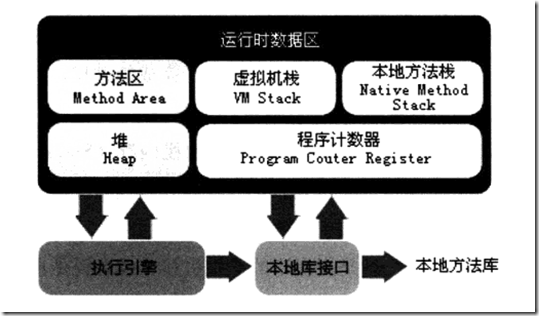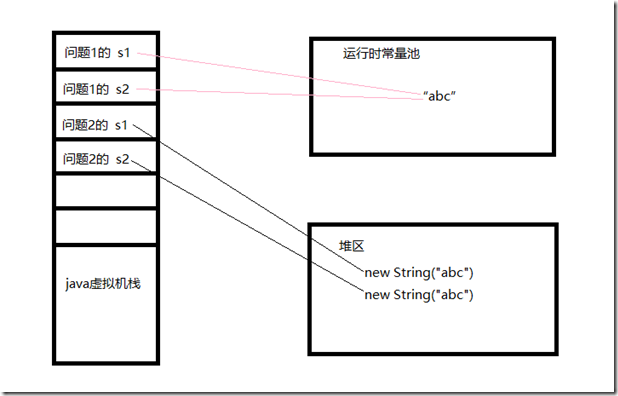- 1python+wxauto实现微信助手
- 2基于asp.net的电影院订票售票管理系统_基于asp.net的电影票销售系统
- 3AttributeError: module ‘numpy‘ has no attribute ‘float‘_attributeerror: module 'numpy' has no attribute 'f
- 4数学符号大全
- 5Termux详细教程!_termux教程
- 6yoloV5模型中,x,s,n,m,l分别有什么不同_yolov5n
- 7手把手带你死磕ORBSLAM3源代码(六十五) LocalMapping.cc ProcessNewKeyFrame
- 8Ubuntu18.04.6 LTS安装vnc(xfce桌面或GNOME原生桌面),及实现离线Ubuntu服务器安装软件_vnc ubantu
- 9postman 使用详解_postman requestserializer
- 10允许或拒绝安装未知来源_seuic允许安装密码
java jls8_java基础学习----String
赞
踩
旨在从内存方面看String类的知识点:
1、为何不能被继承(final类)
2、字符拼接时,String类的内存分配问题。
3、String的intern()方法
关于String类经常出现的面试题:
问题1:
String s1 = “abc”;
String s2 = “abc”;
System.out.println(s1 == s2);
结果:true
问题2:
String s1 = new String(“abc”);
String s2 = new String(“abc”);
System.out.println(s1 == s2);
结果:false
问题3:
String s1 = “abc”;
String s2 = “a”;
String s3 = “bc”;
String s4 = s2 + s3;
System.out.println(s1 == s4);
结果:false
问题4:
String s1 = “abc”;
String s2 = “a” + “bc”;
System.out.println(s1 == s2);
结果:true
问题5:
String str = “abc”;
str.substring(3);
str.concat(“123″);
System.out.println(str);
结果:abc
对于以上问题的解答,需要综合jvm内存分配及规范、String的源代码
一、java虚拟机运行时数据区域:
1、程序计数器
2、java虚拟机栈
3、堆
4、方法区(the method area is logically part of the heap)
5、运行时常量池(Each run-time constant pool is allocated from the Java Virtual Machine's method area)
6、本地方法栈(类似于java虚拟机栈,主要运行native方法)

这里主要看下运行时常量池,在jvm规范(SE8)中有如下解释:
A run-time constant poolis a per-class or per-interface run-time representation of the constant_pool table in a class file (§4.4).
It contains several kinds of constants, ranging from numeric literals known at compile-time to method and field references that must be resolved at run-time.
可以看出它常量池(constant_pool table)主要用于存储编译期产生的常量和符号引用,并且在类加载时后存放到方法区的运行时常量池中(run-time constant pool)
 (问题1 和 问题2解释)
(问题1 和 问题2解释)
对于常量表达式,在编译器的优化下,总是在编译时已计算完毕,类加载后放在运行时常量池。(比如说 “a”+ “bc”在编译后,与“abc”是同一个,加载后在运行时常量池中)(问题4在此解答)
常量表达式有如下几种:
A constant expressionis an expression denoting a value of primitive type or a String that does not complete abruptly and is composed using only the following:
• Literals of primitive type and literals of type String //常量
• Casts to primitive types and casts to type String //转换类型
• The unary operators +, -, ~, and ! (but not ++ or –) //单目运算符
• The multiplicative operators *, /, and % //相关运算符
• The additive operators + and -
• The shift operators <>, and >>>
• The relational operators , and >= (but not instanceof)
• The equality operators == and != (§15.21)
• The bitwise and logical operators &, ^, and |
• The conditional-and operator && and the conditional-or operator ||
• The ternary conditional operator ? :
• Parenthesized expressions whose contained expression is a constant expression.
• Simple names that refer to constant variables
• Qualified names of the form TypeName. Identifierthat refer to constant variables
问题3为两个实例对象相加,会再产生一个堆区的实例对象,然后reference s4指向这个新产生的实例对象,所以会返回false;
问题5,查看下String源码对两个方法实现
public String substring(int beginIndex, int endIndex) {
if (beginIndex < 0) {
throw new StringIndexOutOfBoundsException(beginIndex);
}
if (endIndex > value.length) {
throw new StringIndexOutOfBoundsException(endIndex);
}
int subLen = endIndex - beginIndex;
if (subLen < 0) {
throw new StringIndexOutOfBoundsException(subLen);
}
return ((beginIndex == 0) && (endIndex == value.length)) ? this
: new String(value, beginIndex, subLen);
}
public String concat(String str) {
int otherLen = str.length();
if (otherLen == 0) {
return this;
}
int len = value.length;
char buf[] = Arrays.copyOf(value, len + otherLen);
str.getChars(buf, len);
return new String(buf, true);
}
从两个方法的实现上,可以看到,他们从String对象的value属性上获取信息,并未对value进行改动,String对象调用substring方法,就相当于从自己的value上复制一小部分内容,同理,concat方法,相当String对象复制一份一样的value给别人,并在复制的部分追加字符串,将结果返回。上述两个方法都是从String对象上查询信息,而不是改动信息。所以问题5的答案是false
特别指出:
String类有一个本地方法叫intern()-----Constant expressions of type String are always "interned" so as to share unique instances, using the method String.intern.
例如:
public class TestFinal{
public static void main(String[] args) {
String a = "abc";
String b = "ab";
String c = "c";
String d = (b+c).intern();
String e = (b+"c").intern();
System.out.println(a == c);
System.out.println(a == d);
System.out.println(a == e);
}
}
另外面试中常被问到,String类能不能被继承,通过查询String类的源码发现,它是final类的,是不能被继承的
引用如下文章:
《深入理解Java虚拟机++JVM高级特性与最佳实践.pdf》
oracle下载的官方文档:《jls8》《jvms8》
部分引用网上面试关于String的总结


